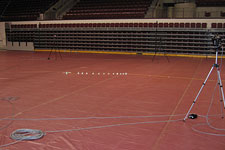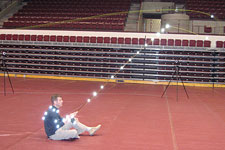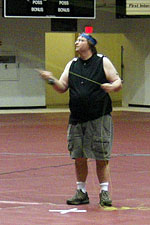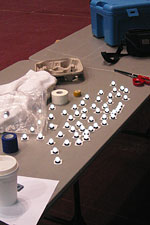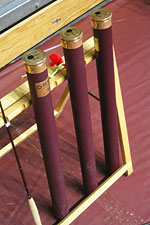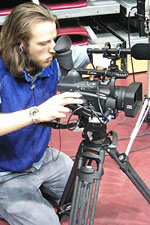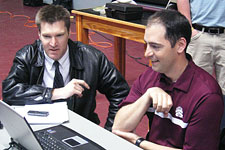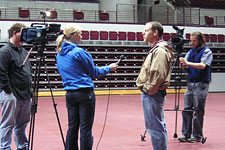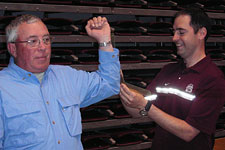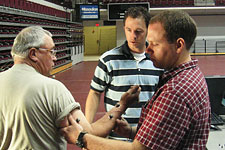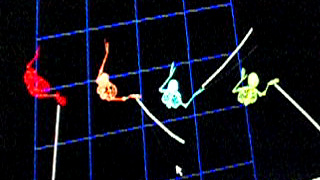by Jason Borger
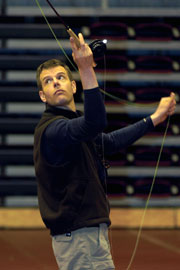 This is a report detailing the April, 2006 fly-casting motion-capture (mo-cap) session, which was held at the Adams Center Gym at the University of Montana in Missoula. In addition to capture involving specific areas of study, the FCI crew also invited a number of other casters to particiapte in order to further enrich the overall biomechanics/medical database. Among those casters was Stann Grater, Chief Fly Fishing Instructor for Orvis. Via Stann, Orvis supplied the FCI with a collection of Zero Gravity rods. The FCI would like to thank both Stann and Orvis for their generous support. The core crew for this capture session included the FCI's "usual supects": Dr. Mike Hahn (MSU-Biomechanics/FCI Research Director), Dr. Tim McCue (Head Team Physician-University of Montana/FCI Medical Director) and myself, as well as MSU post-grad student Josh Allen (who has done some great fly-casting research and skeletal modeling since this project first began).
This is a report detailing the April, 2006 fly-casting motion-capture (mo-cap) session, which was held at the Adams Center Gym at the University of Montana in Missoula. In addition to capture involving specific areas of study, the FCI crew also invited a number of other casters to particiapte in order to further enrich the overall biomechanics/medical database. Among those casters was Stann Grater, Chief Fly Fishing Instructor for Orvis. Via Stann, Orvis supplied the FCI with a collection of Zero Gravity rods. The FCI would like to thank both Stann and Orvis for their generous support. The core crew for this capture session included the FCI's "usual supects": Dr. Mike Hahn (MSU-Biomechanics/FCI Research Director), Dr. Tim McCue (Head Team Physician-University of Montana/FCI Medical Director) and myself, as well as MSU post-grad student Josh Allen (who has done some great fly-casting research and skeletal modeling since this project first began).
One of the best aspects of this mo-cap session was the Adams Center itself. The big gym allowed for true full-line casting, which was something that had been more difficult to achieve in previous mo-cap locations. The gym also had a matte-finish floor and no windows, which made the camera set-up and capture process much easier and faster overall. U of M's Athletic Department was very kind indeed to allow the FCI to have such a great location for so many hours!
|
|
|
(top left) The casting area at U of M's Adams Center (note the reflective fly rod in the center). Definitely the best stage so far for the FCI's studies. No floor reflections, no windows, lots of room--the right recipe for good capture. (top right) Me, taking the relaxed approach. (bottom) The long diagonal of the casting area allowed for the full expression of a variety of casting forms, as well as big distances. |
In addition to the science and medicine-based aspects of fly-casting research, this session saw the beginning of a documentary on the FCI as part of a graduate video project. Film-maker Rick Smith, from Montana State University, shot large segments of the capture session in HD for future intergration into a completed video. If the quality of his shots are any indication, it will be a really nice piece. Rick also joined the FCI for its June 2006 Clinic, where he shot significantly more footage and ran a series of interviews with Clinic participants.
|
|
|
(left) The "table of pain." The little reflective balls are easy to stick onto one's skin, but not quite so easy to get off. The process is now a part of the FCI's "hazing" rituals--you have to do it to get into the club! (middle) Orvis Zero-G rods, ready for abuse. A special thanks to Orvis and Stann Grater for the gear. (right) Documentarian Rick Smith shooting part of his HD project on the FCI. His work was pro and his gear rendered beautiful shots. |
Local news media also taped some of the mo-cap, and did interviews focusing of the FCI's reserach and how it realtes to understanding casting as a whole and the stress/injury patterns seen in both amateur and professional anglers. Not exactly your normal "sports center" report....
|
|
|
(left) U of M's main media man, Cary Shimek (on left), chats with Tim about the results of a capture and how it relates to angler stress/pain. (right) Montana Today news producer/anchor, Hasalyn Harris, interviews Mike about the biomechanics aspects of the FCI. |
The FCI's casting database is maturing, and more abstracts, papers and articles are now available or on the way. Some data in this April session was used as supporting information in an article entitled, "The Rod and the Cast" (Løvoll and Borger, 2006), which is being published in several languages in fly-fishing magazines worldwide. Further data from various capture sessions has been integrated into a recent paper by Josh ("Upper Extremity Kinematic Trends of Fly-Casting: Establishing the Effects of Line Length"). The FCI hopes to have a PDF version of Josh's paper on this site in the future.
|
|
|
(left) Stann Grater (left) going through the motions (literally) with Tim, as Tim provides an upper-extremity mobility exam. Everyone who casts on the mo-cap system goes through this process. (right) Stann getting the second half of his hazing for entry into the FCI casting club. Josh (in center) and Mike making sure the reflective balls are in the correct positions to record joint velocity and range-of-motion. This aspect of the research has resulted in the publication of several biomech abstracts (available on this site) and a 27-page paper from Josh. |
Another benefit of a maturing database, and the related software, is the ability to compare multiple casters all at once, in skeletal form. A number of the casters from the April session were re-built as skeletons in the mo-cap sofware and then placed in a row on the digital casting platform. By doing this, one caster can serve as a "control," while the others serve as comparative studies of form, or one caster can be shown casting at multiple distances simultaneously, or....there are many possibilities.
|
|
|
Skeletal comparsion of four different casters. To see this in action in QuickTime7 video, click here. To see this in action in Windows Media 9 Video, click here. |
One of the next steps for the FCI is to publish several articles on the cast itself--the internal workings of hauls, thrusts, extreme rod rotation and other focused aspects of more advanced fly casting. These articles may appear on this site, in magazines and as part of other collaborative efforts. We will keep you updated as information becomes available.
Photos by Jason Borger, Dr. Tim McCue and the University of Montana (courtesy of Cary Shimek).
Copyright © Fly Casting Institute. All Rights Reserved.
![]()
